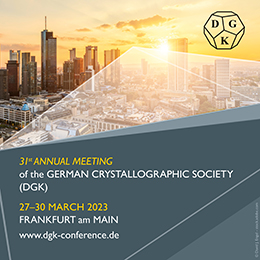


Editorial
Editorial
![Thumbnail [Thumbnail]](https://www.iucr.org/__data/assets/image/0008/155726/Editorialthumbnail2.gif)
Every quarter, as Editor, I get anxious that we shall not have enough material to publish in the following issue of the IUCr Newsletter. But fear not; somehow, the articles keep coming in, often at the last moment, especially recently. So, in this issue of the IUCr Newsletter, we have much interesting material. I have always encouraged articles on the history of our science, as I believe that it is important for scientists to be aware of how our forefathers struggled to come up with the ideas that today we take for granted.
![[Fig. 1]](https://www.iucr.org/__data/assets/image/0007/155743/Fig.-1.png) For example, Jean-Claude Boulliard, Delphine Cabaret and Paola Giura have written an important and detailed account of the life and work of the French cleric René-Just Haüy, sometimes regarded as the father of crystallography. Based on an observation of a broken crystal of Iceland spar (calcite), he inferred that crystalline matter consisted of repeating units (he did not know what they consisted of), which he called “molécules intégrantes.” Although he was not the first to think in such terms – Robert Hooke and Johannes Kepler, for example, also suggested something similar – but it was Haüy who put this on a more scientific basis, for example, through his law of rational indices. We forget, however, just how controversial, and even dangerous, such ideas were in the time and place that he lived (France in the 1790s). Materialism at that point came to be indissociably associated with atheism and atheism with political enemies of the French government. As an example of how Haüy had to be careful, there was an interesting series of lessons published in the archives of the École Normale [1] at the time between someone simply called the “Professeur” and a pupil on the question of heterogeneity or otherwise of solid matter. It is evident that the “Professeur” is Haüy of course!
For example, Jean-Claude Boulliard, Delphine Cabaret and Paola Giura have written an important and detailed account of the life and work of the French cleric René-Just Haüy, sometimes regarded as the father of crystallography. Based on an observation of a broken crystal of Iceland spar (calcite), he inferred that crystalline matter consisted of repeating units (he did not know what they consisted of), which he called “molécules intégrantes.” Although he was not the first to think in such terms – Robert Hooke and Johannes Kepler, for example, also suggested something similar – but it was Haüy who put this on a more scientific basis, for example, through his law of rational indices. We forget, however, just how controversial, and even dangerous, such ideas were in the time and place that he lived (France in the 1790s). Materialism at that point came to be indissociably associated with atheism and atheism with political enemies of the French government. As an example of how Haüy had to be careful, there was an interesting series of lessons published in the archives of the École Normale [1] at the time between someone simply called the “Professeur” and a pupil on the question of heterogeneity or otherwise of solid matter. It is evident that the “Professeur” is Haüy of course!
Readers may recall that some time ago, we published several articles in the Newsletter about the work of Juan Manuel García-Ruiz (“Juanma”) (see an example here) and his study of crystals found associated with the remains of ancient hominids. In this issue, there is an article by Wulf Depmeier celebrating the well-deserved award of the DGK Liebau Prize to Juanma earlier this year. This is followed by an article from Juanma himself, describing some fascinating experiments with chimpanzees where they were introduced to crystals. Most thought-provoking is the way that, given a crystal of quartz, they soon began to take a particular interest in the apparent hexagonal symmetry as seen by looking down the long axis of the crystal. So there seems to be something special about symmetry that causes a response in the chimpanzee’s brain, supporting Juanma’s original suggestion that the discovery of crystals may have played an essential role in the original development of thought processes in humans and an awareness of their surroundings.
Another topical article is a contribution from Istvan Hargittai, this time on the observation of the so-called star polyhedra, a motif that seems to appear in many places. Again, it is the symmetry that attracts attention.
And yet again, the importance of understanding symmetry for crystallographers is raised by Carol Brock, who points out that the IUCr has now made freely available the symmetry diagrams for the 17 plane groups (also known as the wallpaper groups). Carol also reminds us of Escher's wonderful drawings. Escher’s work had been initially spotted by the crystallographer Caroline MacGillavry, who subsequently brought Escher’s work to our attention. I expect that all crystallography teachers have used such drawings to illustrate symmetry principles to students, especially regarding the concept of periodicity in crystals. I would make a point here, though, that the plane groups are two-dimensional symmetry groups, whereas there are no really two-dimensional crystals: atoms are three-dimensional, aren’t they? However, it is perfectly possible to have three-dimensional materials, such as graphene, whose periodicity is only two-dimensional (best described by one of the 80 sub-periodic layer groups). In assessing crystal symmetry, it is important to distinguish between crystal structure on the one hand and the concept of periodicity (usually described by the lattice) on the other.
Again, on the historical theme, Brian Toby has written in memory of Ted Prince, Tony Santoro and Judy Skalick, who are no longer with us. They were three important figures who worked at NIST (National Institute of Standards and Technology, USA) for many years and were well known to many of us. I did not know Judy very much, but I remember several discussions with Ted and Tony. Ted was a formidable mathematician whom I found to be most impressive. Tony had strong opinions, which he expressed freely. My discussions with Tony were always enjoyable and lively: a great character.
Talking about history, 2023 marks the 75th anniversary of the IUCr, founded just after the terrible period of World War II. Jenny Martin has announced that crystallographers around the world will be invited to participate in a refresh of the IUCr’s vision/purpose and values through an online survey in 2023 with the results to be announced during the International Crystallography Congress in Melbourne later that year. By the way, you can find out details of the Congress here.
As usual, we have some obituaries. Sadly, this time all of them were personal friends. Václav Janovec was a colleague working in the scientific area relative to my own research, namely the crystallography of ferroelectrics, and someone with whom I used to discuss symmetry and domain effects in crystals. Ian Munro was the person I first met when I began carrying out early experiments using the NINA synchrotron in Daresbury (UK) and was an enabler for us to carry out experiments, often under challenging conditions. Basia Oleksyn was a friend whom I used to meet during my visits to Kraków, Poland, in the 1980s.
Finally, on a more cheerful note, I am pleased to be able to congratulate Richard Welberry for his award of the Bragg Medal for his work on diffuse scattering, received during the recent meeting of the Society of Crystallographers in Australia and New Zealand (SCANZ) held in Bendigo.
Note
[1] I am grateful to Caroline Warman of Jesus College Oxford for drawing my attention to this document.
Copyright © - All Rights Reserved - International Union of Crystallography









